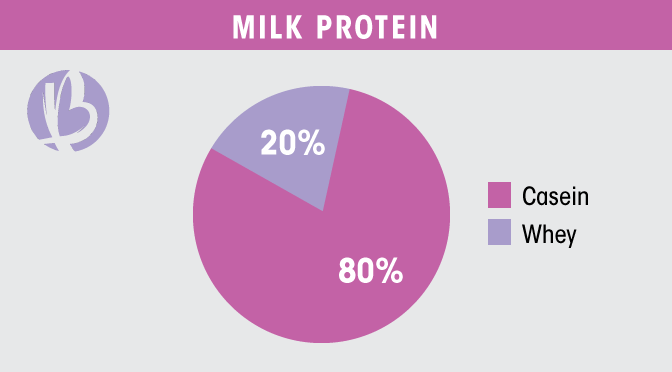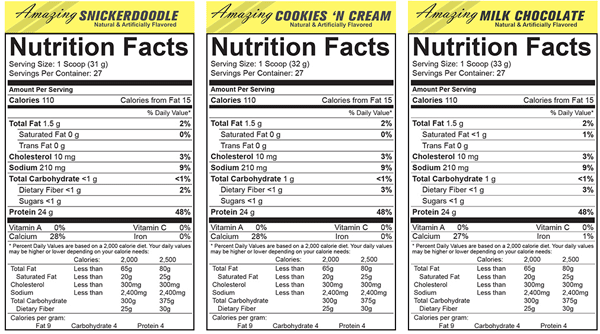Why I Switched Protein Powders
By Kate Horney
If you’ve read the guide above you know that in addition to picking a protein powder for taste (so many different proteins use different sweeteners, etc) you also need to pick a protein powder based on…yep, you guessed it…
For many years my standard post workout protein shake was a basic whey protein powder.
Whey vs. Casein Protein Powder
The protein portion of whole milk consists of:
- 20% whey protein
- 80% casein protein
Whey is by far the most popular type of protein used in protein powders.
For most people, it’s the best all-around choice in terms of taste (it’s one of the best-tasting), quality (it’s the highest) and cost (it’s the most economical).
There’s no disputing the benefits of having a whey protein shake 30-60 minutes after your workout.
Like whey protein, casein protein is another milk protein derivative. Since most of the protein (80%) in milk is casein, the terms “milk protein” and “casein protein” are used interchangeably.
The key difference between whey and casein is that whey is absorbed in the digestive system quickly, whereas casein is absorbed slowly and steadily.
To sum it up: Whey protein spikes muscle protein synthesis and is crucial 30-60 minutes after your workout.
Casein protein creates an anti-catabolic (aka won’t breakdown your muscles) trickle of amino acids throughout the day.
The New Research
Previously, I hadn’t seen these two combined, so since I was primarily using my shake as post workout fuel, I stuck to whey protein shakes after my workouts an an occasional casein shake before bed.
Then came the game changer…
When I stumbled upon my new favorite protein and looked at the research behind their protein line, I was thrilled! Their protein powder has a complementary combination of both.
Anyone who knows me knows that I’m a big science geek. With a degree in Exercise Physiology I love the science and research associated with the fitness industry.
There’s nothing I love more than digging through the internet on a mission to find new ways to help us all #dofitnessbetter.
That’s what drew me to my newfound love: PEScience Select Protein.
If you’ve been drinking your 100% whey protein shake after a brutal workout, that’s good. BUT it may not be BEST.
Nature Has It Right
A whey + casein protein shake is NEW cutting edge science that has been discovered by numerous renowned scientists in over a dozen human trials.
In our quest to build muscle, burn fat, and boost our metabolism, protein is the single most important factor.
When you’re considering your protein intake, you must consider two things:
- The amount of protein
- The type of protein
Reputable journals (I’ll link a bunch below) have already tested the effects of different proteins in human subjects, and the data could not be more conclusive. Whey + Casein is the superior choice.
Whey protein isn’t found alone in nature.
When researchers at the world-renowned Mayo Clinic tested a combination of whey + casein protein, as found naturally in milk protein, they discovered that the two protein sources work together to build lean muscle.
100% whey protein in isolation only gets you so far.
It can spike protein synthesis with an influx of amino acids, which is perfect immediately after a workout but quickly returns to baseline, leaving you where you started.
Enter casein, a slower-digesting protein that’s typically consumed for its anti-catabolic properties as it promotes a steady release of amino acids over time. Casein actually results in more retention of ingested protein than whey!
In another published study, researchers found the combination of whey protein with casein protein resulted in a quick increase in protein synthesis along with a sustained elevation in plasma leucine levels. Plasma leucine levels are a key dictator of muscle protein synthesis, and thus, a combination of whey protein and casein protein may serve to maximize muscle protein accumulation.
Whey protein hits the bloodstream at a fast rate, but it is casein protein that has been shown to create the strongest leucine balance.
It only makes sense to consume them together.
The Solution
So the studies have spoken: a synergistic whey-casein protein blend is the optimal blend for building muscle.
And that’s why I switched my protein powder.
As I mentioned above milk protein is 80% casein and 20% whey, and is my favorite source of casein. It also happens to be the #1 ingredient of SELECT Protein.
With Milk Protein Isolate, they’ve trimmed down the fat and carbohydrate content from milk, leaving you with the 20/80 whey-casein protein ratio and synergistic growth factors intact.
I landed upon PEScience as the solution + my protein powder of choice because of the quality of the protein.
Here’s the scoop: Whey Protein Concentrate (WPC) can be composed of anywhere from 34-80% protein. This protein powder uses the highest quality possible, WPC-80 for short. Don’t waste money on those 34% protein powders.
This protein powder not only gives you the most high-grade protein for your buck, but unlike whey protein isolate, WPC-80 actually contains intact growth factors, allowing you to maximize lean muscle growth.
In addition this protein powder contains high levels of leucine, an amino acid that is a key dictator of muscle protein synthesis. Together the leucine, whey, and casein work to build muscle and boost your metabolism like never before.
Here’s How it Works
Phase 1: By enhancing the blend with pre-digested leucine peptides, we allow for blood levels of leucine to spike, which then spikes muscle protein synthesis and lean muscle building. You see, leucine peptides are pre-digested and absorbed very rapidly, allowing for greater bodily utilization of leucine for the preservation of muscle mass.
Phase 2: Whey protein comes in next and gives your body the other essential amino acids to build new muscle proteins. But it is important to keep this sustained for longer than whey alone can.
Phase 3: Casein protein finishes the job by sustaining lean muscle accrual for hours after your protein shake. It’s the 1-2-3 punch that you need. You’ll have muscle protein synthesis going round-the-clock from a single scoop of protein powder.
It’s a win-win.
So do you “just whey?“
Maybe the answer has been yes for all these years, as it was for me. But it’s time to give your body what it needs to fully #dofitnessbetter.
Want to give it a try?
Get 30% off your entire order when you use the coupon code “BEYONDFIT” at PESCIENCE.com.
References:
1: Soop, Mattias, et al. "Coingestion of Whey Protein and Casein in a Mixed Meal: Demonstration of a More Sustained Anabolic Effect of Casein." American Journal of Physiology (2012): n. pag. Print.
2: Shah NP. Effects of milk-derived bioactives: An Overview. Br J Nutr (2000) 84 (Suppl1): S3-S10.
3: Phillips, SM. Eating the Right Proteins to Support Muscle Mass with Exercise. Presentation at the 4th International Whey Conference, 2005.
4: McDonald, Lyle. The Protein Book. N.p.: n.p., n.d. Web.
5: Paul, George L. "The Rationale for Consuming Protein Blends in Sports Nutrition." Journal of the American College of Nutrition 28.4 (2009): 464S-72S. Web.
6: Butteiger, D. N., M. Cope, P. Liu, R. Mukherjea, E. Volpi, B. B. Rasmussen, and E. S. Krul. "A Soy, Whey and Caseinate Blend Extends Postprandial Skeletal Muscle Protein Synthesis in Rats." Clinical Nutrition 32.4 (2013): 585-91. Web.
7: Reidy, P. T., et al. "Protein Blend Ingestion following Resistance Exercise Promotes Human Muscle Protein Synthesis." The Journal of Nutrition 143.4 (2013): 410-16. Web.
8: Reidy, Paul, et al. "Effect of Protein Blend vs Whey Protein Ingestion on Muscle Protein Synthesis following Resistance Exercise." The FASEB Journal (2012): n. pag. Web
9: Churchward-Venne, Tyler A., Nicholas A. Burd, and Stuart M. Phillips. "Nutritional Regulation of Muscle Protein Synthesis with Resistance Exercise: Strategies to Enhance Anabolism." Nutr Metab 9.40 (2012): n. pag. Web.
10: Salehi, Albert, Ulrika Gunnerud, Sarheed J. Muhammed, Elin Ostman, Jens J. Holst, Inger Bjorck, and Patrik Rorsman. "The Insulinogenic Effect of Whey Protein Is Partially Mediated by a Direct Effect of Amino Acids and GIP on B-cells." Nutr Metab (London) 9.48 (2012): n. pag. Web.
11: Claessens, Mandy, Wim H. M. Saris, and Marleen A. Van Baak. "Glucagon and Insulin Responses after Ingestion of Different Amounts of Intact and Hydrolysed Proteins."British Journal of Nutrition 100.01 (2008): n. pag. Print.
12: Kerksick, Chad M., Christopher J. Rasmussen, Stacy L. Lancaster, Bharat Magu, Penney Smith, Charles Melton, Michael Greenwood, Anthony L. Almada, Conrad P. Earnest, and Richard B. Kreider. "The Effects of Protein and Amino Acid Supplementation on Performance and Training Adaptations During Ten Weeks of Resistance Training."The Journal of Strength and Conditioning Research 20.3 (2006): 643-53. Print.
13: Walker, T. B., J. Smith, M. Herrera, B. Lebeque, A. Pinchak, and J. Fischer. "The Influence of 8 Weeks of Whey-protein and Leucine Supplementation on Physical and Cognitive Performance." Int J Sport Nutr Exerc Metab 20.5 (2010): 409-17. Web.
14: Casperson, S. L., M. Sheffield-Moore, S. J. Hewlings, and D. Paddon-Jones. "Leucine Supplementation Chronically Improves Muscle Protein Synthesis in Older Adults Consuming the RDA for Protein." Clinical Nutrition 31.4 (2012): 512-19. Web.
15: Rieu, I, et al. "Leucine Supplementation Improves Muscle Protein Synthesis in Elderly Men Independently of Hyperaminoacidaemia." The Journal of Physiology 575.1 (2006): 305-15. Print.
16: Norton, L. E., G. J. Wilson, D. K. Layman, C. J. Moulton, and P. J. Garlick. "Leucine Content of Dietary Proteins Is a Determinant of Postprandial Skeletal Muscle Protein Synthesis in Adult Rats." Nutrition & Metabolism 9.1 (2012): 67. Web.
17: Koopman, R, et al. "Combined Ingestion of Protein and Free Leucine with Carbohydrate Increases Postexercise Muscle Protein Synthesis in Vivo in Male Subjects." AJP: Endocrinology and Metabolism 288.4 (2004): E645-653. Web.
18: Lacroix M, Bos C, Leonil J, et al. "Compared with casein or total milk protein, digestion of milk soluble proteins is too rapid to sustain the anabolic postprandial amino acid requirement." Am J Clin Nutr. 2006 Nov;84(5):1070-1079.
19: Boirie, Yves, et al. "Slow and Fast Dietary Proteins Differently Modulate Postprandial Protein Accretion." Proceedings of the National Academy of Sciences 94.26 (1997): 14930-4935. Web.
20: Reitelseder, Soren, et al. "Whey and Casein Labeled with L-[1-13C]leucine and Muscle Protein Synthesis: Effect of Resistance Exercise and Protein Ingestion." American Journal of Physiology Endocrinology and Metabolism 300 (2011): n. pag. Web.





